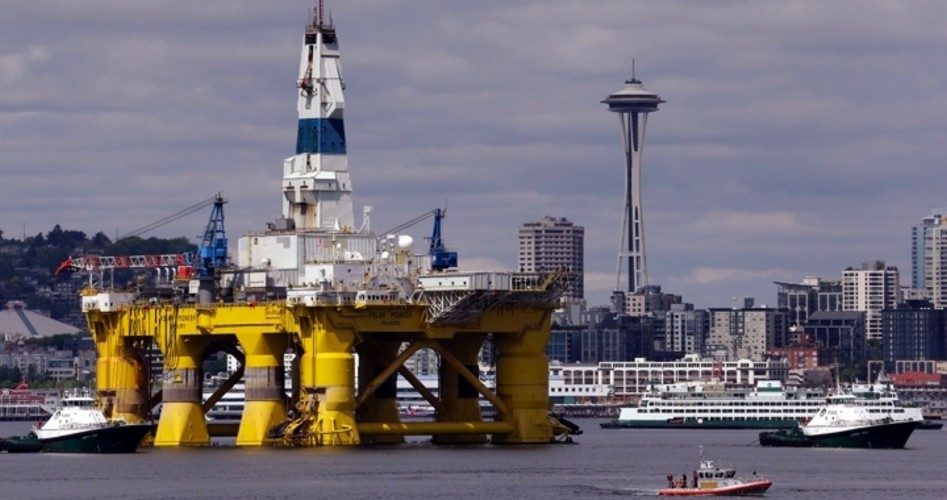
On Monday the U.S. Department of the Interior issued a final approval to allow Royal Dutch Shell to start drilling an exploratory oil well in the Chukchi Sea, northwest of Alaska. Though the Department of the Interior is headed up by Sally Jewell, who was handpicked by the Obama administration for her background not only as the former CEO of REI, a Seattle-based outdoor equipment retailer, but as a die-hard Democrat contributor, the announcement nevertheless enraged environmentalists who remember both the Valdez oil spill and the 2010 Deepwater Horizon blowout.
The last time Shell drilled in the Arctic Ocean was 1991, and environmentalists have been keeping the pressure on succeeding administrations to make it the only time. In 2008, however, Shell successfully invested $2.1 billion in a lease to drill, and since then has invested more than $7 billion in an attempt to tap into what some estimate to be the largest cache of oil and natural gas on the planet.
That’s $10 billion without a single drop of oil or one cubic foot of natural gas to show for it.
The obstacles facing Shell would have neutered a smaller company. The fourth-largest energy company in the world, with a balance sheet approaching a third of a trillion dollars, it is willing to take a risk that its competitors have shied away from. For instance, Christophe Margerie, then-CEO of the French oil company Total S.A., told the Financial Times in 2012 that an “oil [spill] … would be a disaster. A leak would do too much damage to the image of the company.” The company’s current CEO, Patrick Pouyanne, concurred: “At $50 a barrel, it does not make any sense.”
And after Shell’s problems with its multi-billion-dollar Kulluk rig that ran aground in 2012, ConocoPhillips and Norwegian oil giant Statoil suspended their own Alaskan Arctic drilling plans.
Claudio Descalzi, head of the Italian oil company Eni, also demurred: “It’s too complicated. Everything that is too complicated is too expensive and too risky — and my job is to reduce risk.”
A report from Ernst & Young spelled out that risk: “The intense cold for much of the year, long periods of near-total darkness, the potential ice-pack damage to offshore facilities, the marshy tundra dictating seasonal activity in many areas … will take a huge toll on equipment and personnel.”
But Shell appears willing to take those risks, learn from its mistakes in 2012, and satisfy the environmentalists in the hopes that it will succeed in unlocking the vast potential under the oceans there. As Shell spokesman Curtis Smith explained: “The program has been fortified by new assets, an increased number of vessels, but most notably a new drilling rig. It’s our view [that] we have put together the most environmentally sensitive, technically sound Arctic program ever assembled, and if we didn’t have confidence in it, we wouldn’t execute it, even if we had all the permits.”
However, a spill there would be vastly different from the Deepwater Horizon oil spill because of the fierce weather conditions in the Chukchi Sea. Environmentalists such as Franz Matzner, director of the Beyond Oil Initiative at the Natural Resources Defense Council, have concluded that the risks are too great:
Shell has already proven itself not up to the challenge of development in the Arctic Ocean. But it’s not just Shell. The fact is, there’s no safe way to pursue oil exploration in the frozen wastes of the Arctic Ocean. This is an inexplicable decision to do something that is dirty, dangerous and unnecessary.
To emphasize the point, “kayaktivists” tried to block Shell’s drilling rig, called the Polar Pioneer (shown), from leaving Seattle in June. Early Monday morning, June 15th, 16 kayakers surrounded the 400-foot-long, 300 foot-tall colossus in their protest. The U.S. Coast Guard had to remove them before the rig could be towed out to sea.
A reasonable question to ask would be this: Why bother? With all the opposition, all the hassle, all the expense, and the risk of damage to the company’s reputation in the event of a spill, why throw good money after bad?
Because that is what capitalists do. They perceive a need, a demand, an opportunity, they assess the risks, and, when all is said and done, take the plunge (pun intended).
What is the potential reward? In the immediate area where Shell is exploring, the Interior Department has estimated that there are 22 billion barrels of recoverable oil, using today’s technologies. At $50 a barrel, that’s $1.1 trillion. And that doesn’t count the 93 trillion cubic feet of natural gas that’s also estimated to be there.
But according to the U.S. Geological Survey, in its own assessment of a much wider area than where Shell is drilling, there could be 412 billion barrels of oil. At $50 a barrel that translates into $20.6 trillion.
Compared to that, the $10 billion that Shell has already made in its high-stakes gamble could turn out to be just a rounding error.
Photo of Shell’s Polar Pioneer: AP Images
A graduate of an Ivy League school and a former investment advisor, Bob is a regular contributor to The New American magazine and blogs frequently at www.LightFromTheRight.com, primarily on economics and politics.



